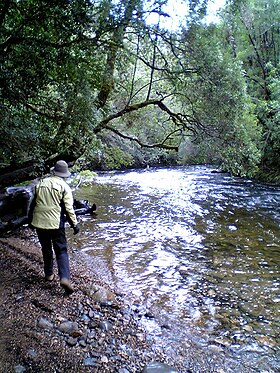Franklin River
| Franklin | |
| River | |
|
Franklin River near the Lyell Highway
|
|
| Name origin: Sir John Franklin | |
| Country | Australia |
|---|---|
| State | Tasmania |
| Regions | Central Highlands, Western |
| Part of | Gordon River |
| Tributaries | |
| - left | Surprise River, Loddon River, Jane River |
| - right | Collingwood River, Lucan River, Andrew River |
| Landmark | Gordon Splits |
| Source | Mount Hugel |
| - location | Franklin-Gordon Wild Rivers National Park |
| - elevation | 951 m (3,120 ft) |
| - coordinates | 42°18′48″S 146°12′56″E / 42.31333°S 146.21556°E |
| Mouth | Gordon River |
| - elevation | 11 m (36 ft) |
| - coordinates | 42°35′27″S 145°44′24″E / 42.59083°S 145.74000°ECoordinates: 42°35′27″S 145°44′24″E / 42.59083°S 145.74000°E |
| Length | 129 km (80 mi) |
| Reservoirs | Lake Undine; Lake Dixon |
| National parks | Franklin-Gordon Wild Rivers; Southwest |
The Franklin River is a major perennial river located in the Central Highlands and western regions of Tasmania, Australia. The river is located in the Franklin-Gordon Wild Rivers National Park at the mid northern area of the Tasmanian Wilderness World Heritage Area. Its source is situated at the western edge of the Central Highlands and it flows west towards the West Coast.
The river is named in honour of Sir John Franklin, a Governor of Tasmania, who later died searching for the Northwest Passage.
The river rises below Mount Hugel west of Derwent Bridge on the western slopes of the Central Highlands and flows generally west and south through remote and rugged mountainous country until meeting its confluence with the Gordon River. From source to mouth the river is joined by sixteen tributaries including the Surprise, Collingwood, Lucan, Loddon, Andrew and the Jane rivers. In its upper reaches, the Franklin is impounded by two reservoirs, Lake Undine and Lake Dixon. The river is crossed by the Lyell Highway, also in its upper reaches. There are some archaeological sites that have identified pre-European activity. The upper reaches of the Franklin River were traversed by explorers in the nineteenth century, in their attempts to access Frenchmans Cap.
In the early twentieth century, access to the river was mostly pine logging in the lower reaches.
In the middle of the century, adventurous canoers sought to conquer the river's formidable challenges. The book Shooting The Franklin : Early canoeing on Tasmania's wild rivers identifies three trips in the 1950s.
...
Wikipedia


